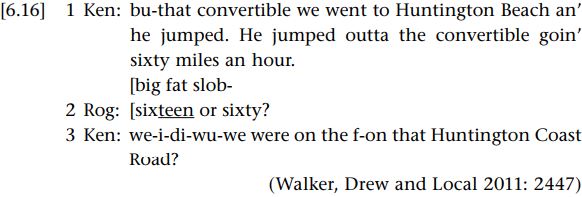


 Grammar
Grammar
 Tenses
Tenses
 Present
Present
 Past
Past
 Future
Future
 Parts Of Speech
Parts Of Speech
 Nouns
Nouns
 Verbs
Verbs
 Adverbs
Adverbs
 Adjectives
Adjectives
 Pronouns
Pronouns
 Pre Position
Pre Position
 Preposition by function
Preposition by function 
 Preposition by construction
Preposition by construction
 Conjunctions
Conjunctions
 Interjections
Interjections
 Grammar Rules
Grammar Rules
 Linguistics
Linguistics
 Semantics
Semantics
 Pragmatics
Pragmatics
 Reading Comprehension
Reading Comprehension| Reflections: An alternative approach to indirect speech acts from conversation analysis (CA) |
|
|
|
Read More
Date: 13-5-2022
Date: 4-5-2022
Date: 13-5-2022
|
Yet another promising approach to indirect speech acts is that proposed by Walker et al. (2011), where they analyses the sequential environments in which indirect speech acts arise in everyday conversation. In this approach, the focus is not on the psychological conditions for what counts as a felicitous speech act or how they are processed, but rather on what actions are interactionally achieved through indirect speech acts. In their study they analyze, in particular, indirect responses to polar interrogatives (i.e. yes-no questions). In their view, indirectness is treated as a property of the relationship between current and preceding turns, that is, between the design or form of responses to preceding inquiries. More specifically, indirect responses to polar questions are treated as indirect when they: (1) are non-type-conforming (i.e. they are not yes/no prefaced); (2) do not use ellipsis, repetition or pronominalisation to tie the response back to the preceding inquiry; (3) require some kind of inferencing to be understood as responses to the prior turn. These inferences draw from prior talk that is non-contiguous (i.e. not in the immediately preceding turn) (cf. co-text) and/or from shared knowledge (cf. common ground).
The key assumption underlying a CA approach to indirect speech acts is that users accomplish interactional business through them; indirect speech acts are not simply deployed as a way of being polite. Walker, Drew and Local (2011) propose that indirect responses to polar questions are used to manage two recurrent interactional issues: (1) uncovering the perceived purpose or agenda displayed in the prior turn; (2) treating the prior inquiry as inapposite, that is lacking or deficient in some way. In example [6.16], Roger’s inquiry is treated as inapposite by Ken, because it involves “basic knowledge” that he would be expected to know as a “hotrodder” (teenage boys who make their reputations by driving their cars fast, or at least by talking about driving fast cars).

Ken is narrating a story about “reckless behavior” when he is interrupted by an inquiry from Roger in the form of a polar question (turn 2). Rather than responding with a type conforming “sixteen” or “sixty”, however, Ken reiterates the fact that they were driving on that Huntington Coast Road. Through the demonstrative that, Ken appeals to shared knowledge, namely, “what speed they (as hotrodders) were likely to be going” on Huntington Road. This knowledge is treated as “basic”, hence the inappositeness of Roger’s inquiry.
|
|
|
|
للعاملين في الليل.. حيلة صحية تجنبكم خطر هذا النوع من العمل
|
|
|
|
|
|
|
"ناسا" تحتفي برائد الفضاء السوفياتي يوري غاغارين
|
|
|
|
|
|
|
نحو شراكة وطنية متكاملة.. الأمين العام للعتبة الحسينية يبحث مع وكيل وزارة الخارجية آفاق التعاون المؤسسي
|
|
|